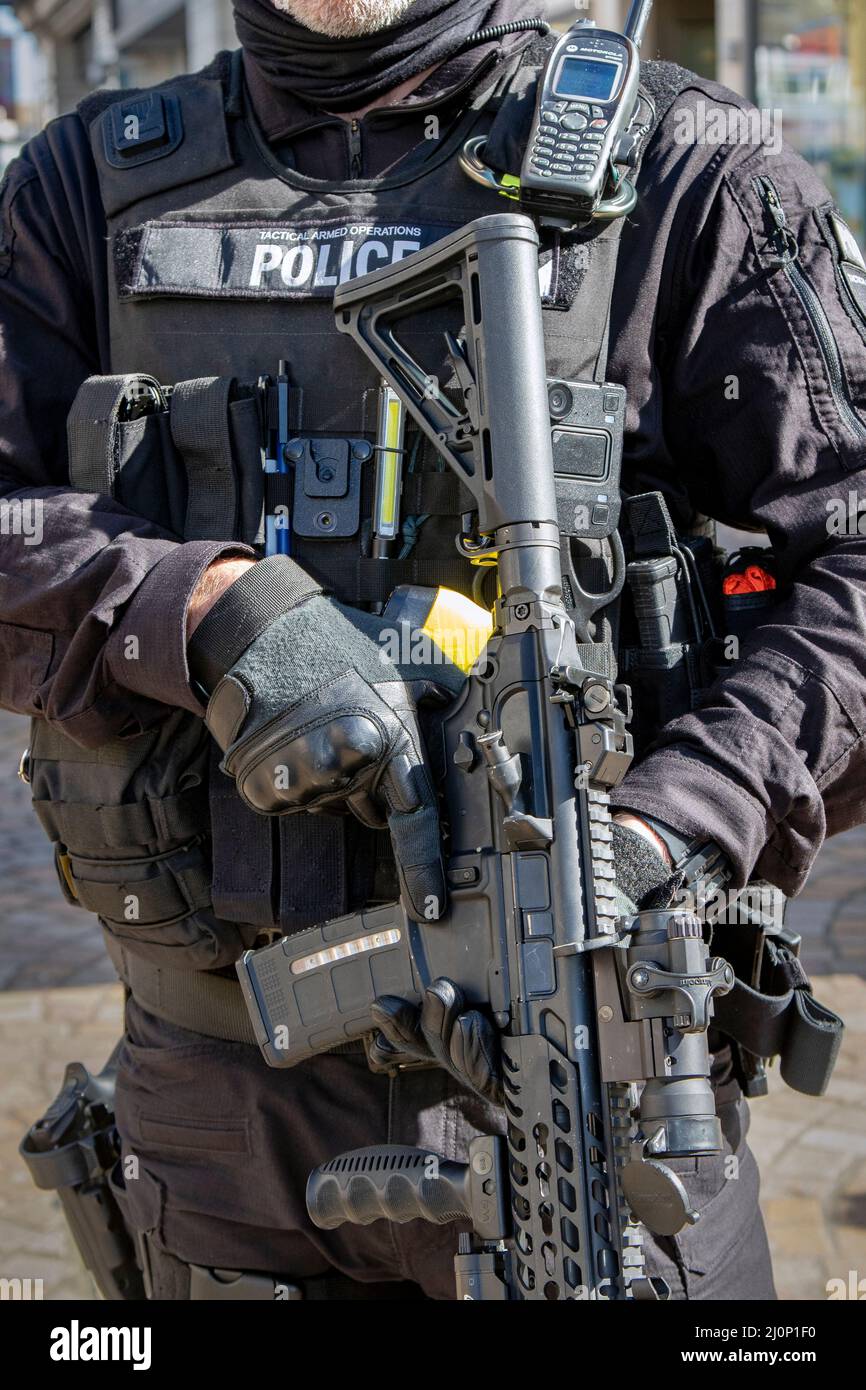Thoughts> What Rights and Responsibilities Govern the Use of Reasonable Force in the UK? An Exploration of Citizens' Arrest and Personal Safety
Thoughts> What Rights and Responsibilities Govern the Use of Reasonable Force in the UK? An Exploration of Citizens' Arrest and Personal Safety
Balancing Act: Understanding the Delicate Line Between Legal Protection, Personal Safety, and Moral Obligation in Self-Defense and Citizens' Arrests in the UK
This article delves into the nuanced world of reasonable force within the UK's legal framework, providing an expanded view of escalating steps in using force. From verbal commands to the deployment of police dogs and helicopters, it examines the progression of responses, aiming to offer a comprehensive understanding of legal and practical considerations in maintaining personal safety and order.

Introduction
In a society that cherishes law and order, the power and responsibility to enforce rules do not rest solely with law enforcement authorities. There is a delicate balance in the UK between the rights and duties of citizens to intervene in crime prevention and their obligation to act within the bounds of legality and humanity. This balance raises thought-provoking questions and moral dilemmas, as ordinary people sometimes find themselves in extraordinary situations where action may be required.
From the reasonable force that may be applied to prevent harm to the intricate legal steps involved in a citizen's arrest, the landscape is riddled with legal subtleties and ethical considerations. How do we define what's "reasonable" in the face of imminent danger? What are the legal and moral responsibilities when a person takes the law into their own hands to arrest another citizen? And how do we escalate our response in a measured way, ensuring both safety and justice?
This article delves into these multifaceted issues, unraveling the legal frameworks that guide the use of reasonable force by UK citizens. It provides a comprehensive overview of the escalating steps of response, from a mere verbal request to potentially mobilizing helicopters and police dogs, and the sensitive undertaking of a citizen's arrest.Through a careful examination of definitions, legal boundaries, escalation procedures, and the unique aspects of a citizen's arrest, we will explore the nuanced interplay between law, ethics, and practical realities.
Whether you are a legal professional, a law enforcement officer, or simply a concerned citizen, the insights shared in this article may reshape how you perceive your rights and responsibilities within the framework of UK law.
Reasonable Force: Definition and Legal Boundaries
The concept of reasonable force in the UK encompasses a complex set of legal principles and practical considerations, tailored to serve justice while respecting human rights.
Definition
Reasonable force refers to the level of force that is deemed acceptable in specific circumstances to prevent a crime, protect oneself or others, or carry out a lawful arrest. It must be proportional, necessary, and reasonable given the situation.

Legal Framework
- Common Law: Under common law, individuals are allowed to use reasonable force to protect themselves or others, prevent crime, or assist in the lawful arrest of offenders.
- Criminal Law Act 1967: This Act permits the use of force, as long as it is reasonable in the circumstances, to prevent crime or arrest offenders.
- Human Rights Act 1998: This Act requires that any force used must be compatible with the European Convention on Human Rights, particularly Article 2, which protects the right to life, and Article 3, which prohibits torture and inhuman or degrading treatment.
- Householders’ Defense: The Crime and Courts Act 2013 introduced a provision that a householder’s use of force is not to be regarded as unreasonable simply because it was disproportionate, as long as it was not grossly disproportionate. This provides householders with greater protection under the law.
Proportionality and Necessity
The concept of proportionality and necessity is key in determining the reasonableness of force. It considers factors like:
- The Nature of the Threat: Was the threat immediate and serious? Did it justify the level of force used?
- The Level of Force Used: Was the force employed the minimum needed to achieve the desired result?
- Individual Circumstances: Age, gender, physical capability, and personal beliefs may also be taken into account.
Limitations and Responsibilities
While the law empowers individuals to use reasonable force, it also sets limits:
- Must Avoid Escalation: If possible, one must try to retreat or de-escalate the situation.
- No Retribution or Punishment: Force cannot be used as a form of punishment or vengeance.
- Accountability: The use of force will be subject to scrutiny, possibly leading to legal proceedings if deemed excessive or unjustified.
Conclusions
The legal boundaries governing reasonable force in the UK are designed to balance personal protection, societal safety, and ethical considerations. Through a blend of statutory laws and common law principles, the law seeks to provide clear guidance while allowing for the complexities of real-world scenarios. Education, public awareness, and constant reevaluation of these laws are essential to ensuring that they continue to serve the interests of justice and human rights.
Escalating Reasonable Force Steps: A Detailed Analysis
The application of reasonable force follows a carefully calibrated pathway that escalates according to the situation's complexity and the threat level. Understanding this escalation is crucial in law enforcement and civilian self-defense.
1. Verbal Request:

- What It Entails: Calmly and clearly issuing verbal commands or requests to cease unlawful behavior.
- When to Use: As an initial attempt to resolve the situation peacefully.
- Considerations: Tone, language, clarity, and context all matter. Success may depend on communication skills and the aggressor's receptiveness.
2. Physical Restraint:

- What It Entails: Employing physical holds or restraints.
- When to Use: If verbal commands fail and physical control is needed.
- Considerations: Techniques must minimize harm, and the force must be proportionate to the threat.
3. Use of Non-Lethal Tools:
- What It Entails: Utilizing batons, pepper spray, or other non-lethal means.
- When to Use: When an aggressor escalates the threat, such as brandishing a weapon.
- Considerations: Must balance effectiveness with potential harm.
4. Deployment of Taser or Other Non-lethal Weapons:
- What It Entails: Using Tasers or similar non-lethal tools.
- When to Use: When non-lethal tools are insufficient, and a higher level of control is required.
- Considerations: Requires specialized training and is subject to strict regulations.
5. Use of Lethal Force:

- What It Entails: Utilizing firearms or other lethal means.
- When to Use: Only when there is an immediate and serious danger to life.
- Considerations: Must be a last resort, and the decision will be heavily scrutinized.
6. Further Escalation:
- What It Entails: Deploying specialized units, police dogs, helicopters, or additional support.
- When to Use: For complex and high-threat situations.
- Considerations:
- Police Dogs: Can provide tracking and apprehension support but must be handled with care.
- Helicopters: Used for tracking from above, requiring coordination and specialized equipment.
- Combined Efforts: Involving multiple resources requires careful planning, communication, and adherence to protocols.
Conclusions
The escalation of reasonable force is a multifaceted process that requires a deep understanding of the legal framework, situational analysis, human behavior, and various tools and techniques at one's disposal. It emphasizes a gradual and proportionate response, aligned with the complexity and threat level of the situation. From verbal requests to the possible deployment of helicopters and dogs, each step is governed by principles of necessity, proportionality, and accountability. Training, guidelines, public awareness, and ongoing assessment are vital in ensuring that this escalation serves the interests of justice, safety, and human rights.
Citizens' Arrest: When and How
The act of a citizen's arrest is a complex and significant undertaking, governed by specific laws and ethical obligations. It requires understanding the circumstances under which it may be performed and how to execute it lawfully and responsibly.
When Is It Permitted?
A citizens' arrest in the UK is generally allowed when:
- Witnessing a Crime: A citizen's arrest may be made if an individual witnesses an "indictable offence" being committed. An indictable offence is typically a more serious crime that can be tried in a Crown Court.
- Preventing Escape: If a person is in the act of committing an offence or has just committed one, and there's no police officer present, a citizen may act to prevent that person from escaping until law enforcement arrives.
How to Perform a Citizens' Arrest
Here's a step-by-step guide to executing a citizen's arrest properly:
- Verbal Declaration: It's essential to tell the person clearly that they are being placed under citizen's arrest, identifying the crime witnessed. A strong command like "Stay There!" can clarify the intention and be useful later if the person resists.
- Use of Force: Reasonable and proportionate force may be used to restrain the individual if they resist or try to escape. This force must be justifiable and not excessive.
- Call the Authorities: It's crucial to call the police as quickly as possible, explaining the situation and following their instructions.
- Provide Care and Protection: While the person is in your custody, you must provide necessary first aid if needed and protect them from harm, including from any angry bystanders.
- Handover to Police: Upon the arrival of law enforcement, a detailed explanation must be provided, and the person must be handed over to their custody.
Considerations and Responsibilities
- Legal Risks: A citizen's arrest carries risks, including potential legal liability if performed incorrectly.
- Safety Concerns: Both the person performing the arrest and the person being arrested may be at risk of physical harm.
- Moral Obligation: The responsibility extends beyond merely detaining the individual; it includes their welfare while in custody.
Conclusion
A citizen's arrest is a significant legal and moral responsibility that requires a careful understanding of the law and a thoughtful, humane approach. Witnessing the crime, clearly stating the arrest, insisting on compliance, using reasonable force if necessary, and ensuring care are all integral parts of this process. Public education, legal guidance, and an awareness of the potential risks and responsibilities are vital for those considering undertaking a citizen's arrest. Because, if you get it wrong - you'll be bang in trouble!
The Security Industry Authority (SIA): A Transformational Force
Introduction
In response to growing concerns about professionalism, training, and standards within the private security industry, the UK government established the Security Industry Authority (SIA) in 2003. This independent organization oversees door supervisors, security guards, close protection officers, and others within the sector, ensuring a uniform standard of quality and conduct.

Key Functions
- Licensing: The SIA is responsible for licensing individuals working in specific sectors of the private security industry. It ensures that those applying for a license meet the necessary criteria, including identity checks, criminal record checks, and qualification assessments.
- Setting Standards: By defining clear and measurable standards for training and conduct, the SIA ensures that those working in the industry are qualified and adhere to a professional code of conduct.
- Enforcement and Compliance: Regular inspections and active monitoring enable the SIA to ensure adherence to the regulations and take corrective actions if necessary.
Transforming the Security Industry The introduction of the SIA has had a profound and positive impact on the security industry:
- Increased Professionalism: By setting minimum standards for training and qualifications, the SIA has fostered a greater sense of professionalism and competence within the industry.
- Enhanced Public Trust: Through transparent regulations and enforcement, the SIA has helped build public confidence in private security services, making people feel safer and more secure.
- Improved Working Conditions: The introduction of standardized practices and a focus on continual professional development has created better working conditions and career progression opportunities for those in the field.
- Alignment with Law Enforcement: Collaboration between the SIA and law enforcement agencies has streamlined efforts to maintain public safety and provided clearer guidelines for cooperation.
- Protection Against Malpractice: By actively monitoring and taking action against unlicensed activity, the SIA protects both the industry's reputation and the public from potential harm.
Conclusion
The Security Industry Authority's inception has marked a significant milestone in the UK's private security landscape. By imposing a regulatory framework that emphasizes professionalism, integrity, and public safety, the SIA has transformed the industry into a more trusted and valuable part of the broader security ecosystem. The collaboration between public authorities and private entities has become more seamless, ensuring a cohesive approach to maintaining safety and order. In the balance between individual liberties and collective security, the SIA plays a vital role, exemplifying how thoughtful regulation can elevate an entire industry.


